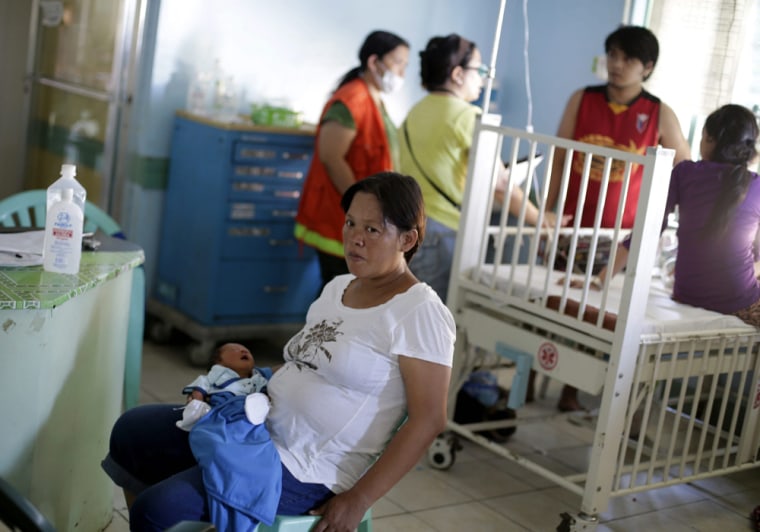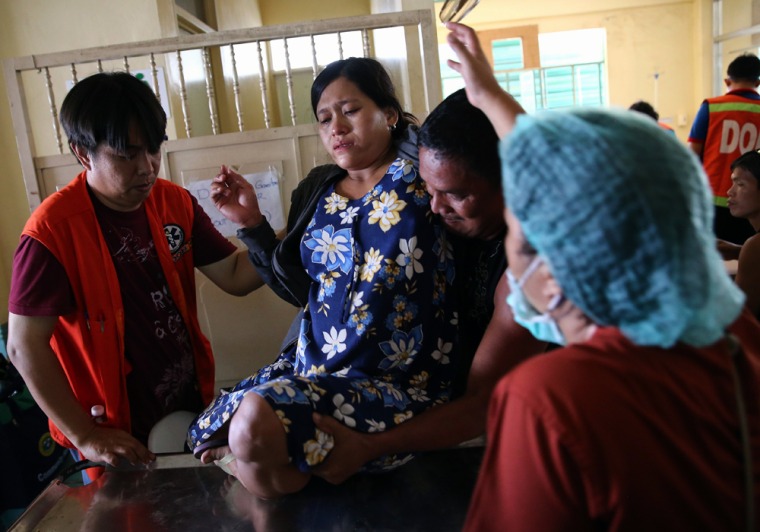Life is coming to a land blanketed in death. But as an estimated 12,000 babies are born in storm-smashed swaths of the Philippines during the next month, many will arrive underweight and ill, adding fresh medical misery to places where all health clinics were swept away.
Doctors with the World Health Organization, treating the sick and injured in areas most punished by the winds and water, confirmed that birth calculation Friday, using known demographic information from those towns and villages. Across the entire nation, some 200,000 women are pregnant, the WHO reported.
But some of those babies are arriving amid dire circumstances. American doctors who volunteer for Mammoth Medical Missions, and who had navigated to the ravaged city of Tanauan, described on Facebook delivering a healthy child Monday night via Caesarean section as showers and violence washed over the area.
“This emergency operation was done in the pouring rain by Dr. (Martha) Kim and Dr. (Rich) Koehler while wearing (mountaineering) headlamps, and other team members holding up the tarp to keep as much rain out as possible. There was also a multiple stabbing scenario, which the team handled well as a group,” read the Facebook post by members of the mission, a nonprofit, secular group of physicians based in Mammoth Lakes, Calif.
That delivery was just one frantic moment of many in Tanauan for 16 U.S. doctors affiliated with the mission. They had set up their MASH unit in a roofless, municipal building.
From Sunday night to Tuesday, Kim – an obstetric gynecologist at Mammoth Hospital – personally delivered or supervised six local midwives in birthing 10 babies. Two babies had to be removed via C-section. One of the midwives, named Golda, was delivering babies when the storm hit land. Her 4-year-old daughter and her sister went missing. They are presumed dead. Yet Golda continued to return each day to work side by side with the American doctor, Kim said.
“The mothers all came to us,” Kim told NBC News on Friday via phone from Manila. “When we got to the facility, a town council building, they had created a makeshift clinic in this totally dirty place. They had a desk shoved into the corner, no screening. We delivered the first baby that night, in the dark, with headlamps, on a desk. That’s how it started.
“Over the next day, we took an office and cleaned it out and set up a little more private place for these ladies to labor and deliver,” Kim said. “There was no roof. The tarps decreased the rain a little but every body still got pretty wet."

All 10 babies entered life healthy, and their mothers were deemed fit as well. Had it not been for the visiting doctors, however, one of the babies delivered by C-section would have faced a high chance of developing cerebral palsy and “would have not done well in the transition after birth,” Kim said. “For the second (C-section-delivered) baby, the mother would not have gotten it out. She had a four-day labor. Her uterus was infected and had stopped contracting. If we hadn’t done a C-section, she and the baby would have died.”
The American doctors were departing the Philippines on Friday, exhausted after five days of work and little sleep. Kim’s concerns were for the female helpers she was leaving behind. She asked for doctors skilled in C-sections to fly to Tanauan to aid the local midwives. She also said the temporary birthing center is in desperate need of forceps and a vacuum device to avoid further C-sections.
Restocking of medical equipment, antibiotics, anesthetics, dressings and health personnel in remote cities like Tanauan is in only the earliest stages, said Christy Feig, director of communications for the WHO.
“Aid is beginning to reach those in need, but there is still a lot of work to get it everywhere it is needed. This response is complicated by the magnitude and scope of the disaster. At least seven provinces have been hit, and because it is an archipelago they are trying to establish a humanitarian hub in each. That is basically the equivalent of mounting seven separate relief efforts – it is an enormous task,” Feig said.
About 20 Filipino medical teams and roughly 20 more international medical units are starting to find routes via vehicle or on foot into massively damaged areas. As of Friday, four of those teams were operational in Tacloban, two in Ormoc, two in Panay, one in Guiuan and one in Palo, the WHO reported.
In Guiuan, a municipality of 47,000 on the southern tip of Samar Island, every medical facility was obliterated by the typhoon, including the only clinic in Eastern Samar province that offered comprehensive obstetric care services. As of Thursday, workers were transporting to Guiuan a number of “reproductive health kits” – sutures for cervical tears and blood-transfusion setups – along with a generator, a refrigerator to store medicines, a delivery bed and midwifery kits, Feig said.
But doctors are bracing for still other medical complications as the babies are born.
Physicians are spreading the word throughout the affected areas that new mothers must breastfeed their infants and avoid mixing powdered formula with water potentially tainted because of breakdowns in the sanitation systems.
“Contaminated formula causes diarrhea, which can easily be fatal in babies and young children,” Feig said. “Breast milk is best. It is the ideal source of nutrition, it is uncontaminated with bacteria and germs, and it contains antibodies that protect babies from infections.”
The Philippine government is also establishing “milk stations” throughout the affected areas at which infant formula will be available and prepared in a safe manner by qualified health staff.
Studies of babies born after past U.S.-bound hurricanes have found higher rates of low birth weights and breathing difficulties, in some cases because blocked roads and closed clinics prevented moms from accessing health care, said Sarah Crittenden Fuller, a post-doctoral research fellow at the University of North Carolina. She has studied the phenomenon, publishing an article in 2012.
“Even in the United States, we find there are worse outcomes for children whose mothers were pregnant with them during a disaster,” Fuller said.
“I found there’s reduction in prenatal care. I found evidence there’s a big increase in stress. That certainly would be the case in the Philippines with this massive disaster, which can lead to more pre-term births,” Fuller said. “So we’re talking about a situation with health-care facilities already overloaded and potentially having more babies born with higher needs.”
As she prepared to leave Manila Friday, Dr. Martha Kim reflected on the blur of days in which she delivered 10 lives in the middle of all the dying. She recalled how she had watched the terrorist attacks of Sept. 11, 2001, on television and then went to help mothers have their babies.
“I remembered thinking then that I’ve got a job to do and babies are coming into the world,” Kim said.
“I definitely had a similar feeling with this. I was so busy and so concentrated on our labors and our group of midwives. But I got that feeling again – life goes on, life continues no matter how unbelievable it may be outside.”
Related stories
- Why wasn't the Philippines better prepared for the typhoon?
- How to help: Organizations offering relief to survivors
- Philippine workers fight clock to name dead while digging mass grave
